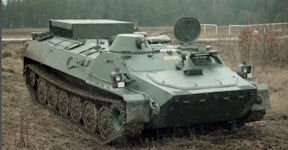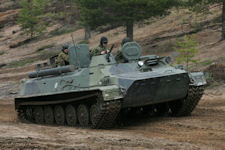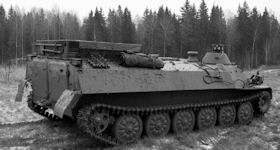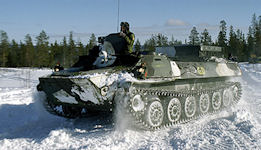Pansarbandvagn 401 (Pbv 401)
The PBV 401 (MT-LB modified for Swedish conditions) combat vehicle was solely used for transportation of rifle units and carries between 8-11 soldiers depending on storage availability. MTLB is a Soviet-made, tracked and armored crew transport vehicle. The advantages of MTLB are good off-road mobility and general technical reliability, as well as good versatility for different tasks. The wagon provides protection for the crew from rifle-caliber weapons and shrapnel from grenades. The MT-LB fulfilled its purpose well in the mechanization of the Swedish infantry and Norrland brigades. However, the vehicle was not designed as a an infantry fighting vehicle, so the shooting group had to walk the last 200 m into the attack target.
The Swedish army had for a long time been very poorly developed in terms of mechanization and fragmentation protection. In order to speed up mechanization for a small sum of money, it was decided in the early 1990s to procure a cheap carriage from the east until it was possible to equip the army with modern, better and more expensive carriages.
PBV 401 as it came to be called in the Armed Forces was bought from the former GDR at a very favorable price. A total of 800 carriages were procured, of which 160 were scrapped to create spare parts. There were then 460 PBV401 and 90 BGBV 4012 left. The PBV 401 was originally a Russian-developed vehicle that was produced in large numbers within the then Warsaw Pact.
The origin has resulted in certain properties known to Russian equipment. The dimensions of the trolley often differ from copy to copy, which adds to things when it comes to spare parts and service. The steel in the trolley also has varying quality, but is usually very good. However, it is well built and lasts well.
The engine , which is located in the middle of the car, is a diesel V-8 that develops a full 240hp at only 2100rpm, which in itself means that the car has a strong torque.
PBV401 has a very low profile, which makes it very suitable for platform for PV-Robot 56. However, this has resulted in the inner height of the trolley being relatively low, and it can easily become crowded. The armament consists of a KSP m / 95 which is mounted in a small tower, this is handled by the wagon commander. The armament may seem substandard, but given that the chariot is mostly used as a "rolling shelter", and not an offensive weapon in itself, the KSP is sufficient as an armament.
The carriage has a very soft and good suspension. The passability in even very deep snow is good, especially if the trailer is equipped with the wider model of tires. The communication equipment consists of an R-123M or an RA-180/480 as well as an intercom system with sockets for drivers, wagon managers, group managers and, where applicable, robot shooters, and then on the roof.
The driver's and wagon commander's space is accessible through two hatches in the front of the wagon and through the battle space via a small passage next to the engine compartment. On the left side is the driver, who with the help of two small windows and three prisms drives the car. The poor field of vision for the driver means that the wagon manager often has to stand open to lead the wagon. The trolley is controlled by braking the respective belts with two different levers and thereby steering the trolley. This can feel a little unusual and get a little jerky in the beginning but works well after a little training.
The carriage manager usually stands up through the hatch in the front center of the carriage and leads the carriage during its journey. If the wagon commander acts shut down, he staffs the machine gun with the associated periscope and prisms. The machine gun is aimed with a handlebar and periscope, and is fired electrically with a button. However, the KSP is a bit cumbersome to charge as the space inside the tower is small. At the shooter's place is also the radio for which the wagon commander is responsible.
The battle space in the back of the carriage is reached via the two rear doors or one of the two battle hatches on the roof. You sit on two bunks, with your back to the car body, along the long sides. The shooting interior consists of a roof mount for a KSP m / 58 and a Grg m / 48 and is located in the middle of the front part of the combat space. In the middle of the rear part of the combat space is a stand for 6 Pskott m / 86 . On the left side, at the front of the space, extra ammunition, hand grenades and other equipment you need quick access to are stored. For a PV robot 56 groupa stand for 3 robots is added, which is located in a stand on the right side of the space or in the corridor between the driver / wagon commander's space and the combat space. The latter is a not so popular solution by drivers and wagon managers as their only alternative escape route is filled with robots. The robot interior also consists of a bracket for a cab and sight box, these under the KSP / Grg bracket, and a bracket for the robot system on the roof.
There is also a company manager interior for the trolley. Then the bracket for KSP / Grg and Pskott has been given space for tables and brackets for radios. Then the trolley is called Stripbv4011 or Stripbv4015 . The only exterior that distinguishes the trolley from foreign ones of the same type is that it is w / 90 painted, has turn signals and lanterns for driving on public roads and that it is equipped with a stuffing box on the roof. In this box, group material is stored and in compartments on the back of the box there is space for 10 Strvmina5 and other material.
The vehicle normally runs trough the terrain with speeds varying between 5-70 km/h (~3-45 mph) and is completely armoured, therefore the transportation room provides no visual or auditory contact to the outside world. The standard equipment for Swedish army soldiers, which included a standard uniform with a vest fitted onto the outside of the uniform containing weapon belongings and survival equipment. Fully functional, the soldiers’ equipment weighted about 30 kilos (approximately 66 Lb) and an extra 5 kilos (approximately 11 Lb) for the rifle.
In the Swedish armed forces, combat vehicle PBV 401 personnel in rifle units are exposed to motions without the ability to maintain visual contact with the outside environment. Conscripts being transported in this vehicle can sometimes be exposed to motions for several hours and at the same time must prepare or perform tasks inside the moving vehicle. When the team disembarks, they are expected to get organized quickly and may instantly have to open fire at the enemy. Hence, it is important that the team is not experiencing disorientation or is under the influence of motion sickness after disembarking. However, it is possible that motion sickness among the conscripts is perceived, with the potential to negatively affect targeting performance. If early stages of perceived motion sickness could be reported by the conscripts, then this phenomenon could possibly be diminished.
In November 1990, the CFE agreement, Treaty on Conventional Armed Forces in Europe , had been concluded in Paris between 22 states from the then Warsaw Pact and NATO. The CFE agreement limited the various European countries' holdings of combat vehicles within both the NATO and Warsaw Pact. In the area of application (the area between the Atlantic and the Ural Mountains), the parties accepted weapon levels which meant that 10,000s of tanks, armored vehicles and artillery pieces would be destroyed before the end of 1995. This immediately gave rise to a large surplus of military surplus materiel. Germany quickly offered vehicles and weapons from the former GDR for sale.
Sweden was not covered by the CFE agreement and therefore had the opportunity to purchase these. Sweden thus acquired a few different types of Russian combat vehicles to test in Swedish terrain for the purpose of building knowledge - five troop transport vehicles of type MT-LB in and five tanks of type T-72M1 . The vehicles were thoroughly tested - some MT-LBs were driven over 1000 miles. T - 72 M1 and MT-LB proved to have passability in upper Norrland that exceeded expectations (or fears). The experiments meant a turning point for the assessment of the threat to northern so -called Andinavien. The assessment of what was impeding terrain for the Warsaw Pact's tanks and anti-tank vehicles required a reassessment.
Defense Decision 1992 (FB 92) resulted in a reduction in the number of brigades in the Army from 21 to 16. But with the possibility of an apartment deal with the reunited Germany to buy better used of type MT-LB, so a foundation could still be laid for a more modern and mechanized infantry than the Swedish Armed Forces had previously had. Based on the troop transport version of Pbv 401, some command variants were developed. In these variants, a table and radios had been placed instead of mounts and stands for the various weapons.
Over the years, Pbv 401/4020 has undergone a small number of modifications. Some of the more important were to change the traction of the exhaust pipes, which lead the exhaust gases backwards / downwards instead of sending them in the face of the group manager. Another was to replace the original passenger compartment heater with a safer model, which does not risk exploding like the original. Another important measure was to replace the old Russian radio with Ra 180/480 - but getting the mounts for the Swedish radio turned out to be a difficult exercise because it was not possible to drill in the hard steel armor. In 2008, decommissioning of 251 Pbv 401/4020 ( including system equipment ) began. The phase -out was completed in 2009-2010. After scrapping and demilitarization for sale as surplus equipment to collectors, the remaining 147 Pbv 401 was sold to the Finnish Armed Forces in 2011 for € 2.7 million.
The Finnish Defense Forces procures 147 used MTLB armored personnel carriers and spare parts from Sweden. The value of the procurement contract is EUR 2.7 million. The Defense Forces received the vehicles at the end of 2013. The acquisition will increase the mobility and protection of armored troops. The project will also support the operational capacity of regional forces. MTLB wagons are used as troop transport and command post vehicles for troops. At the same time, older BTR-50 wagons can be taken out of service. The BTR-50 is a wagon designed in the 1950s and acquired in Finland in the 1960s.
| Pbv 401A | Pbv 4012A | Pbv 4020A | ||
|---|---|---|---|---|
| Crew | 2 + 11 man | 2 (fö / vc) + 3 (repgrp) | 2 (fö / vc) + 5 | |
| Combat weight | 12,000 kg | 13,500 kg | 14 800 kg | |
| Length | 6 450 mm | 6 450 mm | 7 250 | |
| Width | 2 850 mm | 2 850 mm | 2 870 | |
| Height | 1 870 mm | 1 870 mm | 2 350 | |
| Ground clearance | 395-415 mm | 395-415 mm | ~ 400 mm | |
| Engine | 8-cyl JaMZ-238W diesel 240 hp | 8-cyl JaMZ-238W diesel 240 hp | JaMZ-238N turbo diesel 300 hp | |
| Gearbox | Manual 6 + 1 gears | Manual 6 + 1 gears | Manual 6 + 1 gears | |
| Speed | 65-80 km / h | 65-80 km / h | 62 km / h | |
| Action radius | 475 km | 475 km | 360 km | |
| Side slope | 25º | 25º | 25º | |
| Backtaking | 35º | 35º | 35º | |
| Obstacle removal | 0.61 m | 0.61 m | 0.61 m | |
| Ditch cutting | 2.41 m | 2.41 m | ||
| Amphibian | Yes (5-6 km / h) | Yes (5-6 km / h) | Yes (5-6 km / h) | |
| Armament | 7.62 mm ksp 95 | 7.62 mm ksp 58B | 7.62 mm ksp 58B | |
| Protection | 3-14 mm armor steel | 3-14 mm armor steel | 3-14 mm armor steel | |
| Number, in service | 460 st, 1995-2010 | 90 st, 1995-2010 | 60 st, 1997-2010 |
|
NEWSLETTER
|
| Join the GlobalSecurity.org mailing list |
|
|
|





